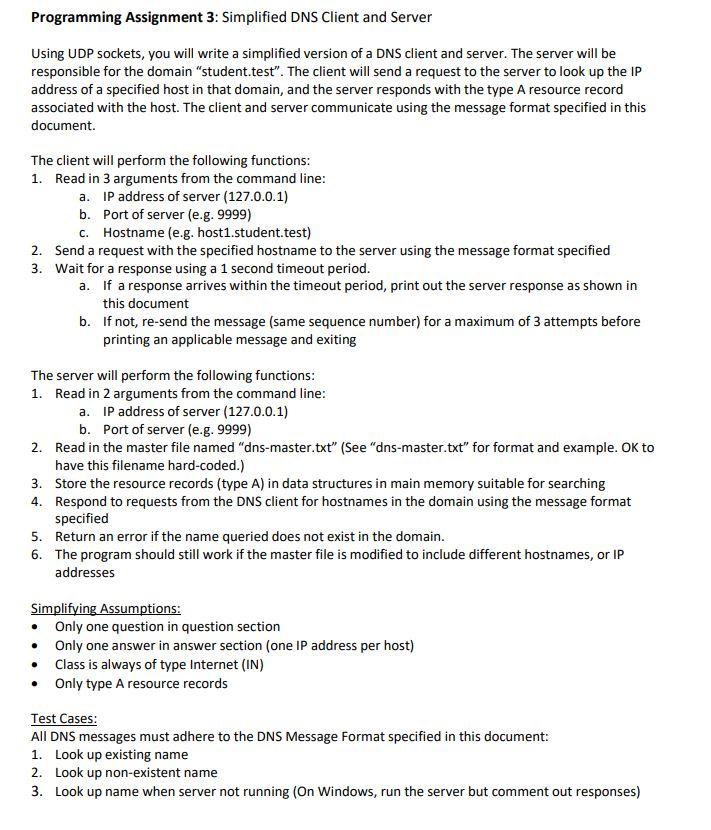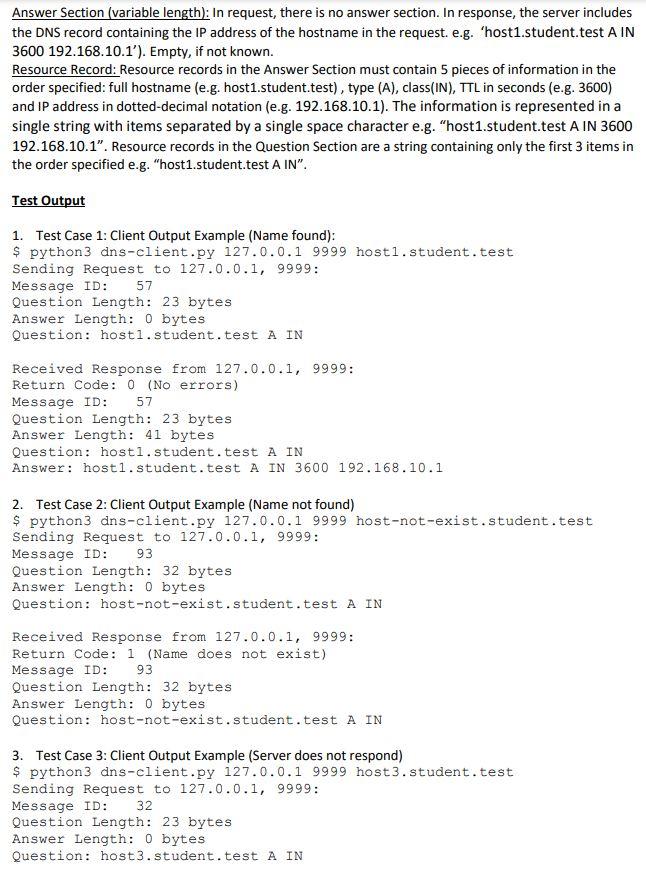Answered step by step
Verified Expert Solution
Question
1 Approved Answer
Please help with the python program Pls include screenshots of output Programming Assignment 3: Simplified DNS Client and Server Using UDP sockets, you will write
Please help with the python program
Pls include screenshots of output




Programming Assignment 3: Simplified DNS Client and Server Using UDP sockets, you will write a simplified version of a DNS client and server. The server will be responsible for the domain "student.test". The client will send a request to the server to look up the IP address of a specified host in that domain, and the server responds with the type A resource record associated with the host. The client and server communicate using the message format specified in this document The client will perform the following functions: 1. Read in 3 arguments from the command line: a. IP address of server (127.0.0.1) b. Port of server (e.g. 9999) C. Hostname (e.g. host1.student.test) 2. Send a request with the specified hostname to the server using the message format specified 3. Wait for a response using a 1 second timeout period. a. If a response arrives within the timeout period, print out the server response as shown in this document b. If not, re-send the message (same sequence number) for a maximum of 3 attempts before printing an applicable message and exiting The server will perform the following functions: 1. Read in 2 arguments from the command line: a. IP address of server (127.0.0.1) b. Port of server (e.g. 9999) 2. Read in the master file named "dns-master.txt" (See "dns-master.txt" for format and example. OK to have this filename hard-coded.) 3. Store the resource records (type A) in data structures in main memory suitable for searching 4. Respond to requests from the DNS client for hostnames in the domain using the message format specified 5. Return an error if the name queried does not exist in the domain. 6. The program should still work if the master file is modified to include different hostnames, or IP addresses Simplifying Assumptions: Only one question in question section Only one answer in answer section (one IP address per host) Class is always of type Internet (IN) Only type A resource records . . Test Cases: All DNS messages must adhere to the DNS Message Format specified in this document: 1. Look up existing name 2. Look up non-existent name 3. Look up name when server not running (On Windows, run the server but comment out responses) Message Format In a DNS request, the application data has the following format in network byte order: 0 1 2 3 (bytes) +-+ -+-+ 4 +-+-+ 1 1 Message Type (1) I Return Code (0) 1 Message Identifier (e.g. 5) Question Length (e.g 23) Answer Length (0) // Question String (e.g. 'host1.student.test A IN') // In a DNS response, the application data has the following format in network byte order: 2 3 (bytes) 0 1 +-+-+- 1 Message Type (2) 4 +-+-+ 1 I Return Code (0 or 1) 1 Message Identifier (e.g. 5) 1 1 Question Length (e.g 23) Answer Length (41) Question Section (e.g. 'host1.student.test A IN') 1 // // 1 // 1 // +-+ Answer Section (e.g. 'host1.student.test A IN 3600 192.168.10.1') +-+-+ Message Type (16 bits): 1 on request; 2 on response Return Code (16 bits): 0 on request; in response, o if name found, 1 if name does not exist Message Identifier (32 bits): Uniquely identifies a message in a request, server echoes same number back in response. Should be generated randomly in range between 1 and 100 Question Length (16 bits): In request and response, length of resource record in Question Section in bytes. Answer Length (16 bits): 0 in request (because no answer section). In response, length of resource record in Answer Section in bytes. Question Section (variable length): In request, String carrying Question in the form of a DNS resource record containing hostname, 'A' and 'IN' separated by a single space e.g. 'host1.student.test A IN'); Echoed back in server response Answer Section (variable length): In request, there is no answer section. In response, the server includes the DNS record containing the IP address of the hostname in the request. e.g. 'host1.student.test A IN 3600 192.168.10.1'). Empty, if not known. Resource Record: Resource records in the Answer Section must contain 5 pieces of information in the order specified: full hostname (e.g. host1.student.test), type (A), class(IN), TTL in seconds (e.g. 3600) and IP address in dotted-decimal notation (e.g. 192.168.10.1). The information is represented in a single string with items separated by a single space character e.g. "host1.student.test A IN 3600 192.168.10.1". Resource records in the Question Section are a string containing only the first 3 items in the order specified e.g. "host1.student.test A IN". Test Output 1. Test Case 1: Client Output Example (Name found): $ python3 dns-client.py 127.0.0.1 9999 host1.student.test Sending Request to 127.0.0.1, 9999: Message ID: 57 Question Length: 23 bytes Answer Length: 0 bytes Question: hosti.student. test A IN Received Response from 127.0.0.1, 9999: Return Code: 0 (No errors) Message ID: 57 Question Length: 23 bytes Answer Length: 41 bytes Question: hosti.student. test A IN Answer: host1.student.test A IN 3600 192.168.10.1 2. Test Case 2: Client Output Example (Name not found) $ python3 dns-client.py i27.0.0.1 9999 host-not-exist. student.test Sending Request to 127.0.0.1, 9999: Message ID: 93 Question Length: 32 bytes Answer Length: 0 bytes Question: host-not-exist.student.test A IN Received Response from 127.0.0.1, 9999: Return Code: 1 (Name does not exist) Message ID: 93 Question Length: 32 bytes Answer Length: 0 bytes Question: host-not-exist.student.test A IN 3. Test Case 3: Client Output Example (Server does not respond) $ python3 dns-client.py 127.0.0.1 9999 host3.student.test Sending Request to 127.0.0.1, 9999: Message ID: 32 Question Length: 23 bytes Answer Length: 0 bytes Question: host3.student. test A IN Request timed out ... Sending Request to 127.0.0.1, 9999: Request timed out Sending Request to 127.0.0.1, 9999: Request timed out Exiting Program. Programming Assignment 3: Simplified DNS Client and Server Using UDP sockets, you will write a simplified version of a DNS client and server. The server will be responsible for the domain "student.test". The client will send a request to the server to look up the IP address of a specified host in that domain, and the server responds with the type A resource record associated with the host. The client and server communicate using the message format specified in this document The client will perform the following functions: 1. Read in 3 arguments from the command line: a. IP address of server (127.0.0.1) b. Port of server (e.g. 9999) C. Hostname (e.g. host1.student.test) 2. Send a request with the specified hostname to the server using the message format specified 3. Wait for a response using a 1 second timeout period. a. If a response arrives within the timeout period, print out the server response as shown in this document b. If not, re-send the message (same sequence number) for a maximum of 3 attempts before printing an applicable message and exiting The server will perform the following functions: 1. Read in 2 arguments from the command line: a. IP address of server (127.0.0.1) b. Port of server (e.g. 9999) 2. Read in the master file named "dns-master.txt" (See "dns-master.txt" for format and example. OK to have this filename hard-coded.) 3. Store the resource records (type A) in data structures in main memory suitable for searching 4. Respond to requests from the DNS client for hostnames in the domain using the message format specified 5. Return an error if the name queried does not exist in the domain. 6. The program should still work if the master file is modified to include different hostnames, or IP addresses Simplifying Assumptions: Only one question in question section Only one answer in answer section (one IP address per host) Class is always of type Internet (IN) Only type A resource records . . Test Cases: All DNS messages must adhere to the DNS Message Format specified in this document: 1. Look up existing name 2. Look up non-existent name 3. Look up name when server not running (On Windows, run the server but comment out responses) Message Format In a DNS request, the application data has the following format in network byte order: 0 1 2 3 (bytes) +-+ -+-+ 4 +-+-+ 1 1 Message Type (1) I Return Code (0) 1 Message Identifier (e.g. 5) Question Length (e.g 23) Answer Length (0) // Question String (e.g. 'host1.student.test A IN') // In a DNS response, the application data has the following format in network byte order: 2 3 (bytes) 0 1 +-+-+- 1 Message Type (2) 4 +-+-+ 1 I Return Code (0 or 1) 1 Message Identifier (e.g. 5) 1 1 Question Length (e.g 23) Answer Length (41) Question Section (e.g. 'host1.student.test A IN') 1 // // 1 // 1 // +-+ Answer Section (e.g. 'host1.student.test A IN 3600 192.168.10.1') +-+-+ Message Type (16 bits): 1 on request; 2 on response Return Code (16 bits): 0 on request; in response, o if name found, 1 if name does not exist Message Identifier (32 bits): Uniquely identifies a message in a request, server echoes same number back in response. Should be generated randomly in range between 1 and 100 Question Length (16 bits): In request and response, length of resource record in Question Section in bytes. Answer Length (16 bits): 0 in request (because no answer section). In response, length of resource record in Answer Section in bytes. Question Section (variable length): In request, String carrying Question in the form of a DNS resource record containing hostname, 'A' and 'IN' separated by a single space e.g. 'host1.student.test A IN'); Echoed back in server response Answer Section (variable length): In request, there is no answer section. In response, the server includes the DNS record containing the IP address of the hostname in the request. e.g. 'host1.student.test A IN 3600 192.168.10.1'). Empty, if not known. Resource Record: Resource records in the Answer Section must contain 5 pieces of information in the order specified: full hostname (e.g. host1.student.test), type (A), class(IN), TTL in seconds (e.g. 3600) and IP address in dotted-decimal notation (e.g. 192.168.10.1). The information is represented in a single string with items separated by a single space character e.g. "host1.student.test A IN 3600 192.168.10.1". Resource records in the Question Section are a string containing only the first 3 items in the order specified e.g. "host1.student.test A IN". Test Output 1. Test Case 1: Client Output Example (Name found): $ python3 dns-client.py 127.0.0.1 9999 host1.student.test Sending Request to 127.0.0.1, 9999: Message ID: 57 Question Length: 23 bytes Answer Length: 0 bytes Question: hosti.student. test A IN Received Response from 127.0.0.1, 9999: Return Code: 0 (No errors) Message ID: 57 Question Length: 23 bytes Answer Length: 41 bytes Question: hosti.student. test A IN Answer: host1.student.test A IN 3600 192.168.10.1 2. Test Case 2: Client Output Example (Name not found) $ python3 dns-client.py i27.0.0.1 9999 host-not-exist. student.test Sending Request to 127.0.0.1, 9999: Message ID: 93 Question Length: 32 bytes Answer Length: 0 bytes Question: host-not-exist.student.test A IN Received Response from 127.0.0.1, 9999: Return Code: 1 (Name does not exist) Message ID: 93 Question Length: 32 bytes Answer Length: 0 bytes Question: host-not-exist.student.test A IN 3. Test Case 3: Client Output Example (Server does not respond) $ python3 dns-client.py 127.0.0.1 9999 host3.student.test Sending Request to 127.0.0.1, 9999: Message ID: 32 Question Length: 23 bytes Answer Length: 0 bytes Question: host3.student. test A IN Request timed out ... Sending Request to 127.0.0.1, 9999: Request timed out Sending Request to 127.0.0.1, 9999: Request timed out Exiting Program
Step by Step Solution
There are 3 Steps involved in it
Step: 1

Get Instant Access to Expert-Tailored Solutions
See step-by-step solutions with expert insights and AI powered tools for academic success
Step: 2

Step: 3

Ace Your Homework with AI
Get the answers you need in no time with our AI-driven, step-by-step assistance
Get Started


